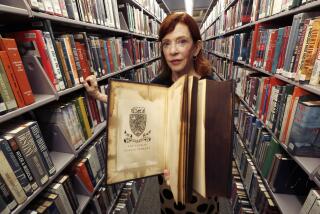Amazon tries a sound approach with Kindle 2
- Share via
LOS ANGELES AND NEW YORK — Amazon.com Inc. on Monday unveiled its second-generation electronic reader, a slimmer and faster version of the Kindle device it introduced 14 months ago with promises to revolutionize the way people read books.
The average American hasn’t come close to abandoning the printed page yet. Electronic books generate less than 1% of the $25-billion U.S. book publishing market.
But they’re a fast-growing segment of an otherwise stagnant industry. Their sales grew 63% in the first 11 months of 2008 compared with 2007, while sales of physical books grew less than 3%, according to the Assn. of American Publishers.
And Kindle owners appear to be fueling their bookworm habits, using the built-in wireless connection to buy more titles than in their print-only days.
Analysts say the $359 device, which will be available Feb. 24, is still too expensive for the mainstream. But Amazon is betting that its paperback-size Kindle will do for the book industry what Apple Inc.’s iPod did for music, said James McQuivey, an analyst with Forrester Research.
The Kindle 2 holds seven times as many books, lasts 25% longer on a battery charge and flips virtual pages more easily than its predecessor, which has been sold out since November. And the device can read aloud.
Amazon Chief Executive Jeff Bezos envisions a day when the stolid industry will shift almost entirely from paper to digital. Among the 230,000 titles that the Seattle bookseller makes available for the Kindle, he said, 10% of all sales are e-books.
“Our vision is every book ever printed in any language, all available in less than 60 seconds,” he said at an event at the Morgan Library and Museum in Manhattan. “We’re making progress.”
Amazon won’t say how many Kindles it has sold, but analysts estimate the figure at about 500,000. Its main competition comes from Sony Corp., which has sold more than 300,000 of its Reader Digital Book devices.
Their budding popularity should propel sales of digital books to about $100 million this year, McQuivey estimates.
“The fact that it’s growing quickly suggests that 10 years from now, we could see digital books as the primary way books are sold, just as we talk today about digital as the primary way music is sold,” he said.
Until then, however, the transition to digital can be a painful one to publishers. They face declining profit margins on physical book sales and have to experiment with new digital formats, placing bets on which ones will catch on.
“Clearly, there’s a market for e-books,” said Ed McCoyd, director of digital policy for the Assn. of American Publishers. “People are intrigued by this form of reading. But it’s still nascent.”
Bezos contends that digital readers can help publishers expand the overall market. Kindle owners bought 2.7 times more books than they did before buying the device, he said.
That is the case with Marilyn Kostry, 57, the chief of clinical services at South Central Los Angeles Regional Center. She bought one after seeing it on “The Oprah Winfrey Show” in August. Since then, she has purchased 42 books, about double her previous book-buying rate.
Kostry, an aficionado of mystery books, said Amazon’s recommendations also led her to discover new authors, such as Ann Rule.
“It’s definitely caused me to read more,” Kostry said. “Sometimes I just can’t get to the bookstore. This way I can get a new book instantly.”
For the new model, Amazon improved many existing features. The most novel aspect is the text-to-speech feature, which enables users to listen to their material.
“Any book, blog, magazine, personal document could be read aloud to you,” said Bezos, as he had a Kindle 2 read the opening lines of the Gettysburg Address with crisp, staccato enunciation.
The device got a promotional boost from author Stephen King. He took the stage to read an excerpt from “Ur,” a novella he wrote at Amazon’s request for the launch of the new Kindle. In the story, a college English professor tries out a Kindle, only to have the device open a portal to supernatural experiences.
“You’re going to like this gadget,” King told the audience. “But you’re going to like books too. It isn’t as though the two things are in conflict with one another. They’re like peanut butter and chocolate -- when you put them together, you’ve got a whole new tasty treat.”
Still, one of the factors holding consumers back is the cost of an electronic reader. Sony’s Reader costs $299 for the basic device, and a touch-screen version costs $399.
“It’s still too expensive,” said Van Baker, an analyst with technology research firm Gartner Inc. “For the average consumer, paper still works pretty well.”
--
--
BEGIN TEXT OF INFOBOX
Kindle 2: A speedier read
The Kindle 2 electronic reader from Amazon.com, due Feb. 24, has some key improvements over the first device, which was introduced in November 2007. The price tag remains the same: $359.
MORE STORAGE
Holds 1,500 books, versus 200 for the first model.
LONGER BATTERY LIFE
Features 25% better battery life and can stay on four to five days on one charge and as much as two weeks with the wireless connection turned off.
IT TALKS
Has a computerized voice that can read text aloud.
FASTER PAGE TURNS
Lets readers flip virtual pages 20% faster.
CRISPER SCREEN
Displays 16 shades of gray, versus four for the old device.
THINNER
Is 0.36 of an inch thick, half the thickness of the older version.
-- Alex Pham
More to Read
Sign up for our Book Club newsletter
Get the latest news, events and more from the Los Angeles Times Book Club, and help us get L.A. reading and talking.
You may occasionally receive promotional content from the Los Angeles Times.





